Scottish Health Survey 2018: main report - revised 2020
An amended version of the Scottish Health Survey 2018 main report.
This document is part of a collection
Chapter 5 Diet
Summary
In 2018, 22% of adults met the 5-a-day recommendation, which is fairly consistent with results since 2003. 10% did not consume any fruit or vegetables on previous day.
15% of children met the 5-a-day recommendation. 10% of children did not consume any fruit or vegetables on previous day.
Average consumption of fruit and vegetables has also remained fairly constant since 2008.
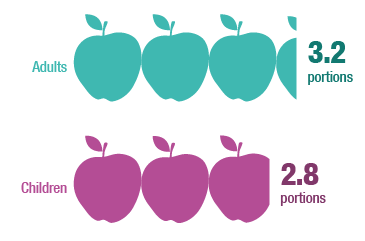
- Non-diet soft drink consumption has fallen considerably for both adults and children.
- In 2018, 10% of adults consumed sugary drinks every day, down from 20% in 2016.
- In 2017/2018, 16% of children aged 2-15 consumed non-diet soft drinks daily, down from 35% in 2015/2016 and 38-39% in the years 2008/2009 to 2013/2014.
Adult consumption of biscuits (at least once a day) and of cakes (two or more times a week) has been declining since 2014.

9% of adults experienced food insecurity in 2018 (as defined by being worried during the past 12 months that they would run out of food due to lack of money or resources).
6% of all adults also said they had eaten less than they should for this reason, while 3% of adults said that they had actually run out of food because of a lack of resources.
In 2017/2018 the household types most likely to have experienced food insecurity were single parents and adults below the age of 65 living alone:
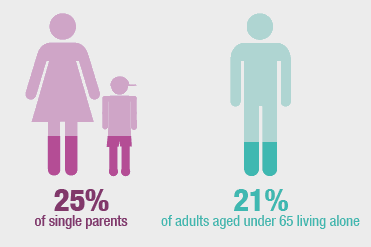
- In 2017/2018, 16% of adults in the most deprived areas reported being worried about running out of food, compared with 4% in the least deprived areas.
- In 2017/2018 mental wellbeing was substantially lower for those reporting food insecurity: mean WEMWBS score of 42.2 compared with 50.3 for other adults.
5 Diet
Stephen Hinchliffe
5.1 Introduction
Globally, poor diet is the second highest risk factor for early death after smoking[1]. In 2017, poor diet accounted for 11 million (one in five) deaths in 195 countries; with diets low in wholegrains and fruits and high in sodium accounting for more than half of these deaths[2]. It was estimated that, in 2015, diets low in fruit and vegetables or high in sugar, processed foods or sodium, directly accounted for 37% of all deaths and just over a quarter of the total global disease burden[3]. International estimates indicate that around a third of cases of cancer[4] and cardiovascular disease[5] worldwide could be prevented by improvements in the nutritional content of diets and overall reductions in body mass[6].
Links between diet, in particular the role of saturated fat and fruit and vegetable intake, and non-communicable diseases such as cancer, cardiovascular disease and Type 2 diabetes are well established[7],[8],[9],[10]. Evidence suggests that vegetable consumption is more important than fruit consumption in reducing the risk of certain types of breast cancer[11],, stroke[12], and diabetes[13], while fruit consumption is more strongly associated with reducing the risk of coronary heart disease in women[6]and oesophagal and stomach cancers[14].
Other dietary factors, including the potentially positive effects of fibre and wholegrains[15],, oily fish intake[16],[17],[18] and antioxidant vitamins[19] have been studied in relation to cancer, cardiovascular disease, rheumatoid arthritis and cognitive decline in later life. Folates have been shown to have a role in the prevention of neural tube defects[20]; vitamin D and calcium are determinants of bone health[21]; salt intake is linked to increased risk of hypertension[22]; and the consumption of red or processed meat is linked to bowel cancer [23],[24] and increased risk of cardiovascular disease and cancer mortality[25]. Sugar is well established as a major cause of tooth decay[26] and free sugars (or added sugars) have been linked to the development of obesity and Type 2 diabetes[27],[28]. In children and young people aged 11-18, sugary drinks have been identified as the key contributor to total sugar intake[29].
The full extent of the economic burden of poor diet is difficult to ascertain[30]. However the economic impact on the NHS is apparent. Treatment of cardiovascular disease (including hypertension), cancer, Type 2 diabetes and tooth decay represent significant costs to the health service. The most recent evidence suggests that unhealthy diet had an economic burden of £5.8 billion in 2006-07; a greater burden on the NHS than smoking, alcohol consumption, overweight and obesity or physical inactivity[31].
This chapter presents data on household food insecurity in Scotland for the second consecutive year. A widely accepted definition of household food insecurity is: 'the inability to acquire or consume an adequate quality or sufficient quantity of food in socially acceptable ways, or the uncertainty that one will be able to do so'[32]. Household food insecurity ranges from worrying about running out of food to running out of food and going entire days without eating due to lack of money or other resources. A 2018 report by the Food and Agriculture Organisation estimated that 2.2 million people in the UK were living in severely food insecure households based on averaged data from 2015 to 2017[33].
Evidence from the US and Canada suggests that food insecurity is associated with poorer diet and health and wellbeing. Household food insecurity is associated with higher fat intake[34] and inadequate intakes of fruits and vegetables[35]. Household food insecurity has also been linked with a range of negative health outcomes across the life cycle. For children, these include low birth weight and some birth defects, compromised development, cognitive problems, anxiety and depression and increased risk of chronic conditions[36]. Adults living in food insecure households are more likely to experience poorer mental health and chronic health conditions, such as diabetes, hypertension, arthritis and heart disease[37],[38] [39].
5.1.1 Policy background
In Scotland there is wide recognition at national policy level that excessive consumption of foods high in fat, sugar and salt and low consumption of fibre, fruit and vegetables and other healthy foods has wide-ranging consequences for the health of the nation.
The Scottish Dietary Goals, revised in 2016[40], provide the basis for a healthy balanced diet, The Goals decribe, in nutritional terms, the diet that will improve and support the health of the Scottish populationand include:
- The World Health Organisation 5-a-day recommendation for adults (to consume at least five varied 80g portions of fruit and vegetables per day).
- To reduce salt intake from around 9g to 6g per day for adults.
- To reduce average calorie intake by 120 kcal per day and average intake of red meat to 70g per day.
- To provide advice on limiting fat and sugar intake and increasing consumption of fibre and oil-rich fish.
- To reduce the average intake of free sugars to 5% of total dietary energy.
- To increase intake of dietary fibre to 30g per day for adults.
- To maintain intakes of starchy carbohydrates at 50% of total dietary energy.
The Eatwell Guide, published in 2016, updated UK advice on healthy eatingto illustrate the proportions and types of foods from major food groups which make up a healthy diet[41]. Following recommendations from the Scientific Advisory Committee on Nutrition (SACN), Scottish Government advice on vitamin D for all age groups has also been updated[42].
The Scottish Government published A Healthier Future: Scotland's Diet and Healthy Weight Delivery Plan[43] in July 2018. The delivery plan set out an ambition to halve child obesity by 2030 and significantly reduce diet-related health inequalities. It sets out a wide range of actions aimed at ensuring:
- Children have the best start in life – they eat well and have a healthy weight.
- The food environment supports healthy choices.
- People have access to effective weight management services.
- Leaders across all sectors promote healthy weight and diet.
- Diet related inequalities are reduced.
Following commitments in the delivery plan and 2018/19 Programme for Government, the Scottish Government has consulted on restricting the promotion and marketing of foods high in fat, sugar or salt (HFSS) with little nutritional value where they are being sold.
To encourage manufacturers to reduce the sugar content of their drinks, in 2016 the UK Government introduced a UK wide soft drinks industry levy[44] to be paid by producers and importers of soft drinks that contain added sugar in April 2018[45]. Since its introduction, over 50% of manufacturers have reduced the sugar content of their drinks, the equivalent of 45 million kg of sugar every year[46].
A consultation to end the sale of energy drinks to children was published by the UK Government in August 2018 with options to restrict sales to those under the age of 16 or 18 being considered. The Scottish Government has committed to a similar consultation in 2019 but has already taken steps to restrict sales of energy drinks in hospitals to those under the age of 16.
In March 2017, Public Health England (PHE) published guidelines for its Sugar Reduction Programme[47]. The programme, which applies across the UK, set a voluntary target to reduce the level of sugar in the categories that contribute most to the intakes of children up to 18 years by 20% by 2020. In Sugar Reduction: Report on First Year Progress[48]a 2% reduction in the first year for retailers' own brand and manufacturer branded products (against a target of 5%) was reported and a reduction in sugar levels in 5 out of the 8 food categories measured. The latest progress update in Spring 2019 sets out plans to produce a second year progress report later in 2019[49].
PHE's calorie reduction programme[50]was published in March 2018. The UK wide programme challenges the food industry to achieve a 20% reduction in calories by 2024 in product categories that contribute significantly to children's calorie intakes (up to the age of 18 years) and where there is scope for substantial reformulation and/or portion size reduction. It does not cover foods included in the sugar reduction programme.
The Scottish Government committed to monitoring household food insecurity in 2016, following recommendations from an Independent Working Group on Food Poverty[51]. The Independent working group was established in response to food bank data evidencing a significant increase in people seeking their support. The data on household food insecurity obtained in the Scottish Health survey informs progress towards the 'zero hunger' indicator in the National Performance Framework, in line with Goal 2 of the UN Sustainable Development Goals. Work to tackle food insecurity is underpinned by the Scottish Government's £3.5 million Fair Food Fund which supports dignified responses to food insecurity that help to tackle the causes of poverty.
5.1.2 Reporting on diet in the Scottish Health Survey (SHeS)
This chapter provides information on fruit and vegetable consumption and other eating habits among adults and children from 2003 to 2018. Figures on food insecurity for adults are also provided for 2017-18 and explored in relation to dietary intake and mental health.
The area deprivation data are presented in Scottish Index of Multiple Deprivation (SIMD) quintiles. Where appropriate, to ensure that comparisons are not confounded by different age profiles within categories, data have been age-standardised. Readers should refer to the glossary at the end of this volume for a detailed description of SIMD and age-standardisation.
Supplementary tables on diet are also published on the Scottish Health Survey website[52].
5.2 Methods and Definitions
5.2.1 Measuring fruit and vegetable consumption
The module of questions on fruit and vegetable consumption was designed with the aim of providing sufficient detail to monitor population-level adherence to the 5-a-day recommendation. These questions have been asked of all adults (aged 16 and over) participating in the survey since 2003 and of children aged 2 to 15 since 2008.
The module includes questions on consumption of the following food types in the 24 hours to midnight preceding the interview:
- vegetables (fresh, frozen or canned);
- salads;
- pulses;
- vegetables in composites (e.g. vegetable chilli);
- fruit (fresh, frozen or canned);
- dried fruit;
- fruit in composites (e.g. apple pie);
- fresh fruit juice.
A portion is defined as the conventional 80g of a fruit or vegetable. Since 80g is difficult to visualise, survey respondents were asked to describe the amount of each fruit or vegetable they consumed using more everyday terms, such as tablespoons, cereal bowls and slices. These everyday measures were then converted to 80g portions prior to analysis. Examples are given in the questionnaire to aid the recall process, for instance, tablespoons of vegetables, cereal bowls full of salad, pieces of medium sized fruit (e.g. apples) or handfuls of small fruits (e.g. raspberries). In spite of this, there may be some variation between participants' interpretation of how much they consumed. The following table shows the definitions of the portion sizes used for each food item included in the survey:
| Food item | Portion size |
|---|---|
| Vegetables (fresh, frozen or canned) | 3 tablespoons |
| Pulses (dried) | 3 tablespoons |
| Salad | 1 cereal bowlful |
| Vegetables in composites, such as vegetable chilli | 3 tablespoons |
| Very large fruit, such as melon | 1 average slice |
| Large fruit, such as grapefruit | Half a fruit |
| Medium fruit, such as apples | 1 fruit |
| Small fruit, such as plums | 2 fruits |
| Very small fruit, such as blackberries | 2 average handfuls |
| Dried fruit | 1 tablespoon |
| Fruit in composites, such as stewed fruit in apple pie | 3 tablespoons |
| Frozen fruit/canned fruit | 3 tablespoons |
| Fruit juice | 1 small glass (150 ml) |
Since the 5-a-day recommendation stresses both volume and variety, the number of portions of fruit juice, pulses and dried fruit is capped so that no more than one portion of each can contribute to the total number of portions consumed. Interviewers record full or half portions, but nothing smaller.
5.2.2 Food Insecurity
Three priority questions from the UN Food Insecurity Experience Scale were included in the 2017 Scottish Health Survey for the first time and have been continued in 2018. The questions are:
During the last 12 months, was there a time when:
You were worried you would run out of food because of a lack of money or other resources?
You ate less than you thought you should because of a lack of money or other resources?
Your household ran out of food because of lack of money or other resources?
In keeping with the administration procedure for the whole scale, the questions are filtered in the survey (with the second and third questions only being asked if the previous is answered 'yes'). Due to their sensitivity, these questions are asked in the adult and young adult self-complete questionnaires.
5.3 Fruit and Vegetable Consumption
5.3.1 Trends in adult fruit and vegetable consumption since 2003
In 2018, 22% of adults met the five-a-day recommendation for consumption of fruit and vegetables. This figure has remained fairly constant since 2003, with only a small amount of variation over the years (between 20% and 24%).
Women were significantly more likely to consume the recommended amount of fruit and vegetables than men in 2018 (24%, compared with 19% of men), a difference that has been evident in most years since 2003.
When looking at other measures of fruit and vegetable consumption, the same patterns can be seen. In 2018, adults consumed an average of 3.2 portions of fruit and vegetables a day, a figure which has varied very little since 2003, while 10% of adults consumed no fruit and vegetables on a typical day[53], a figure which has also not changed much over the intervening years. Mean fruit and vegetable consumption was higher for women than men (3.5 portions a day for women compared to 2.9 portions for men), and a higher proportion of men than women consumed no fruit or vegetables on a typical day (12% and 8% respectively). Again, these differences were present in most of the survey years since 2003.
Figure 5A, Table 5.1
Figure 5A
Percentage of adults consuming five portions of fruit and vegetables a day, and mean portions of fruit and vegetables consumed by adults, since 2003
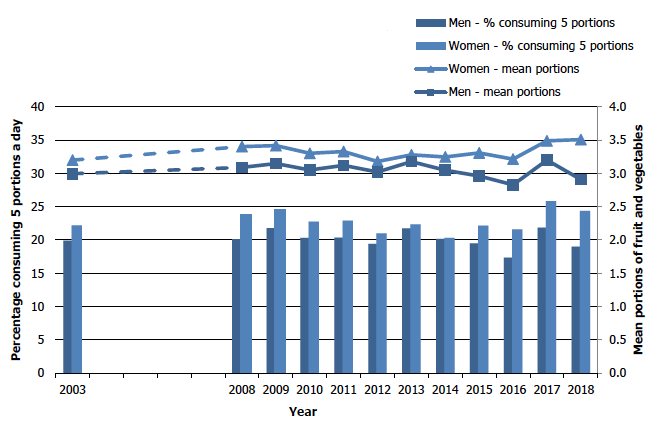
5.3.2 Adult fruit and vegetable consumption in 2018, by age and sex
While women tended to consume more fruit and vegetables a day than men in 2018 (a mean of 3.5 portions, compared with a mean of 2.9 for men), there was little variation by age. For all age groups, mean consumption lay between 3.0 and 3.4 portions a day.
There was, however, a difference in the pattern of consumption for men and women by age. While women aged 75 and over tended to eat less fruit and vegetables than younger women (a mean of 3.0 portions, compared with means of between 3.4 and 3.7 for the other age groups), for men, lowest levels of consumption were in the youngest age group (2.5 portions a day for men aged 16 to 24) and highest for those aged 55 and over (an average of between 3.1 and 3.2 portions a day).
Patterns in the proportion meeting the five-a-day recommendation were similar to those described above for mean consumption. However, those aged 65 and over were more likely to consume at least some fruit or vegetables in a day than those in younger age groups (93% of those aged 65 and over, compared with 87-90% of those aged under 65).
Table 5.2
5.3.3 Trends in child fruit and vegetable consumption since 2008
In 2018, 15% of children aged 2-15 met the five-a-day recommendation for consumption of fruit and vegetables. Boys and girls were equally likely to meet the recommendations, with 15% of girls and 16% of boys having done so. These figures show little variation over time, with figures for all children lying between 12% and 15% each year since 2008.
The same lack of change over time can be seen for mean consumption and for the proportion eating no fruit and vegetables. Mean consumption in 2018 was 2.8 portions for both boys and girls. Mean consumption for all children aged 2-15 has been between 2.6 portions and 2.9 portions a day for all years since 2008.
Similarly, the proportion of children consuming no fruit and vegetables has remained fairly constant since 2008. In 2018, 10% of children aged 2-15 (11% of boys and 9% of girls) consumed no fruit or vegetables on a typical day.
Table 5.3
5.4 Summary of Eating Habits
5.4.1 Trends in adult eating habits since 2008
The most notable change in adult eating habits in 2018 was in the proportion of adults consuming non-diet soft drinks at least once a day, see Figure 5B. This fell from 20% in 2016, and between 23% and 27% in the years 2008 to 2014, to just 10% in 2018. Both men and women reduced their consumption of non-diet soft drinks. The proportion of men consuming these at least once a day fell from 23% in 2016 (between 26% and 30% in the years 2008 to 2014) to 12% in 2018. The proportion of women consuming such drinks fell from 17% in 2016 (21% to 24% in the years 2008 to 2014) to 8% in 2018.
To a lesser extent, there has also been some reduction in the consumption of other sugary products. Frequent consumption of both biscuits and cakes was exhibited by a smaller proportion of adults in 2018 than in the years 2008 to 2014, continuing a downward trend started in 2016. In 2018, 27% of adults consumed biscuits once a day or more, compared with between 31% and 34% of adults in the years 2008 to 2014. Similarly, in 2018, 31% of adults consumed cakes at least twice a week, compared with between 34% and 36% in the years 2008 to 2014.
One other positive change, consolidating the position identified in 2016, was in the consumption of oily fish. In 2018, 31% of adults consumed oily fish at least twice a week (32% in 2016), compared with 24% to 26% in the years 2008 to 2014.
In 2018, women tended to exhibit better diets than men. Women were significantly more likely than men to frequently eat oily fish at least once a week (33% of women, compared with 29% of men) and tuna fish at least once a week (30% of women, compared with 24% of men). Men were more likely to eat red meat at least twice a week (62% of men, compared with 49% of women), meat products (such as sausages, meat pies, bridies, corned beef or burgers) at least twice a week (39% of men, compared with 21% of women), biscuits at least once a day (29% of men, compared with 25% of women), cakes at least twice a week (32% of men, compared with 29% of women), ice cream at least once a week (30% of men, compared with 26% of women), non-diet soft drinks at least once a day (12% of men, compared with 8% of women) and chips at least twice a week (38% of men, compared with 26% of women). All of these differences were evident in at least some, if not all, of the preceding survey years[54].
Figure 5B, Table 5.4
Figure 5B
Adult consumption of non-diet soft drinks once a day or more often, 2008 to 2018
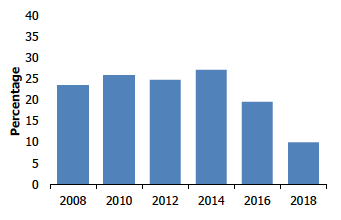
Adult consumption of cakes twice a week or more often, 2008 to 2018
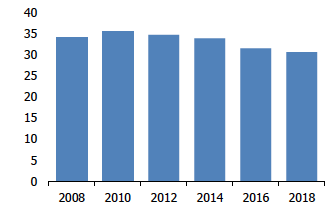
Adult consumption of biscuits once a day or more often, 2008 to 2018
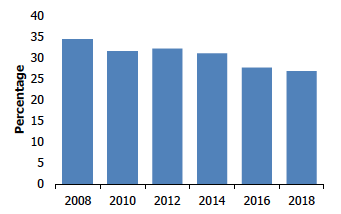
Adult consumption of oily fish twice a week or more often, 2008 to 2018
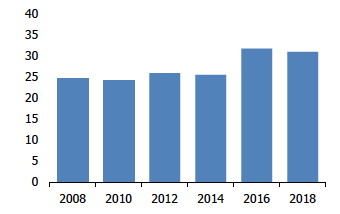
5.4.2 Trends in child eating habits since 2008
Changes in child eating habits reflected the changes described above in adult eating habits. The largest change was in the consumption of non-diet soft drinks, with the proportion of children aged 2-15 consuming such drinks at least once a day falling from 35% in 2015/16 (between 38% and 39% in the years 2008/09 to 2013/14) to 16% in 2017/18. Large drops in consumption were evident for both boys and girls, with 18% of boys and 15% of girls consuming non-diet drinks every day in 2017/18, down from 35% for both in 2015/16.
Consumption of biscuits at least once a day also fell, from 32% in 2015/16 (and 42% in 2008/09) to 28% in 2017/18. Consumption of oily fish once a week or more rose from 13% in 2008/09 and 16% in 2015/16 to 19% in 2017/18. Consumption of high-fibre bread at least two slices of such bread a day fell from 35% in 2008/09 and 32% in 2015/16 to 28% in 2017/18.
A higher proportion of boys than girls ate white fish at least once a week (55% of boys, compared with 49% of girls), while a higher proportion of girls ate tuna fish at least once a week (29% of girls, compared with 24% of boys). Boys were also more likely than girls to eat meat products (such as sausages, meat pies, bridies, corned beef or burgers) at least twice a week (41% of boys, compared with 36% of girls) and biscuits every day (30% of boys, compared with 27% of girls). Girls were more likely to drink skimmed or semi-skimmed milk (58% of girls, compared with 53% of boys) and to eat ice cream at least once a week (53% of girls, compared with 48% of boys).
Table 5.5
5.5 Food Insecurity
5.5.1 Adult food insecurity in 2017 and 2018, by age and sex
Questions on food insecurity were introduced into the Scottish Health Survey in 2017. Levels of food insecurity in 2018 were similar to those discussed in the 2017 report.[55] In 2018, 9% of adults reported that they had been worried they would run out of food at some time during the previous 12 months due to a lack of money or other resources. The majority of these individuals, 6% of all adults, went on to say that they had actually eaten less than they should because of a lack of resources, while 3% said that they had run out of food during the previous 12 months for this reason. Levels of food insecurity did not differ between men and women, with figures for both sexes being the same on all three measures.
Food insecurity was much more common among those under the age of 65 than among older adults: 12% of those aged 16-44 and 9% of those aged 45-64 were worried they would run out of food, compared with just 2% of those aged 65 or over. Similarly, 9% of those aged 16-44 and 6% of those age 45-64 had eaten less than they should because of a lack of money or other resources, compared with 1% of those aged 65 or over, while 4% of those aged 16-44 and 3% of those aged 45-64 had actually run out of food, compared with less than 1% of those age 65 or above.
Table 5.6
5.5.2 Adult food insecurity (age-standardised) in 2017/2018 combined, by area deprivation and sex
In 2017/2018, there was a clear pattern of increasing levels of food insecurity with increasing levels of deprivation. In the most deprived areas, 16% of adults (using age-standardised figures) had been worried they would run out of food because of a lack of money or other resources in the previous 12 months, while 12% said that they had eaten less than they should and 7% that they had actually run out of food for this reason. In the least deprived areas these figures were around a quarter of those levels: 4% had been worried about running out of food, 3% had eaten less than they should, and 1% had run out of food.
Figure 5C, Table 5.7
Figure 5C
Adult food insecurity (age-standardised), 2017/2018 combined, by area deprivation and sex
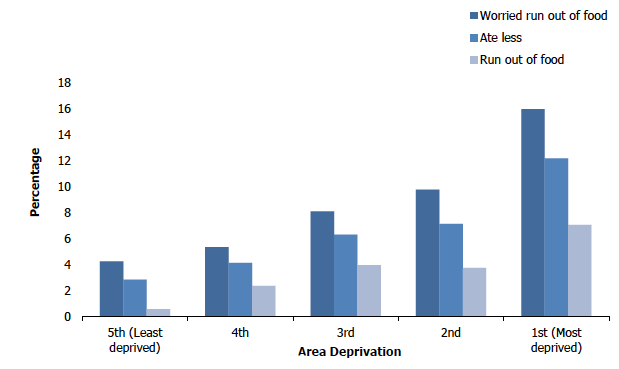
5.5.3 Adult food insecurity in 2017/2018 combined, by household type
In addition to the pattern of food deprivation according to levels of deprivation described above, there were some large differences according to household type. In 2017/2018, a quarter (25%) of single parents (mostly single mothers) reported that they had been worried they would run out of food in the previous 12 months due to a lack of resources. Over three-quarters of these (21% of all single parents) went on to say that they had eaten less than they should, and around half of them (13% of all single parents) said they had actually run out of food due to a lack of resources.
Similarly high levels of food insecurity were seen among both men and women under the age of 65 living alone. One in five (21%) of those below this age living alone were worried they would run out of food (23% of men and 18% of women). The large majority of these (17% of all adults aged under 65 living alone) had eaten less than they should, and more than half of them (12% of all single adults under 65) had actually run out of food.
While not as prevalent as for single adults and single parents, food insecurity was still evident among other household types. Of adult members of large families (two adults and three or more children, or three or more adults and at least one child), 12% had been worried about running out of food because of a lack of resources. Similarly, 9% of adults in small adult households (comprising two adults under the age of 65 and no children), and 8% of adults in small family households (comprising two adults and one or two children) had been worried about running out of food. Levels were lower, at 5%, for adults in large adult households (three or more adults and no one under the age of 16), but lowest of all for people in households made up of older adults (2% for both single older adult households (one adult aged 65 or over), and for adults in households with older smaller families comprising two adults only, at least one of whom is aged 65 or over).
Eating less food and actually running out of food followed the same pattern by household type as described above, albeit at lower levels. While 12% of single adults and 13% of single parents had actually run out of food because of a lack of money or other resources, no more than 4% of any of the other household type had done so.
Table 5.8
5.5.4 Fruit and vegetable consumption, (age-standardised) in 2017/2018 combined, by adult food insecurity
There was an association between fruit and vegetable consumption and experience of food insecurity. This appeared to be driven by a higher proportion of those reporting food insecurity eating no fruit or vegetables, rather than lower fruit and vegetable consumption for all of those experiencing food insecurity. The age-standardised proportion of those who said they had been worried about running out of food in the previous 12 months because of a lack of resources and who ate the recommended five portions a day was not significantly different from that of the rest of the adult population (19% and 23% respectively). However, the proportion of this group who ate no fruit or vegetables on a given day was significantly higher than for the rest of the adult population (17%, compared with 9%).
The mean proportion of fruit and vegetable consumption was lower for those who said they had been worried they would run out of food than for the rest of the adult population. Age-standardised mean consumption among this group was 2.9 portions a day, compared with 3.3 portions for the rest of the population. The same pattern was evident for both men and women, albeit with men consuming fewer portions than women, whether experiencing food insecurity or not. Men who said they were worried they would run out of food consumed an average of 2.5 portions a day, compared with 3.1 for other men, while women who were worried about running out of food consumed an average of 3.2 portions, compared with 3.6 for other women.
Similar figures can be seen when looking at fruit and vegetable consumption according to the other measures of food insecurity. The age-standardised proportion of those who said they ate less than they should because of a lack of money or other resources who consumed the recommended five portions of fruit and vegetables a day was 17% compared to 23% for other adults, though the difference wasn't significant. The difference in the proportions consuming no fruit or vegetables was much more obvious; 18% of those who said they had eaten less than they should consumed no fruit or vegetables the previous day, compared with 9% of other adults. The mean number of portions of fruit and vegetables per day (age-standardised) consumed by those who said they had eaten less than they should was 2.8 compared to 3.3 for the rest of the population.
Of those who said they actually ran out of food, the age-standardised proportion who consumed five portions of fruit and vegetables was 21%, again not significantly different from the 23% consumed by other adults. The age-standardised proportion of those who ran out of food who consumed no fruit and vegetables was 22%, compared with 9% for other adults. Age-standardised mean number of portions were not significantly different for these two groups.
Figure 5D, Table 5.9
Figure 5D
Adult consumption of fruit and vegetables (age-standardised), 2017/2018 combined, by whether worried would run out of food because of a lack of resources
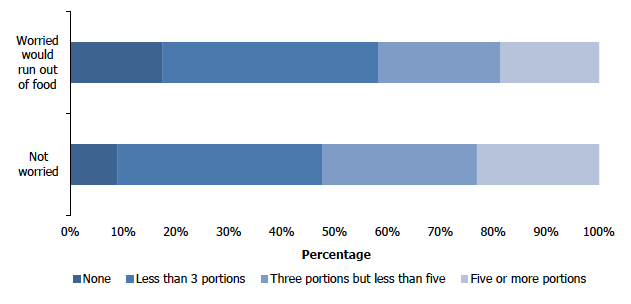
5.5.5 Adult WEMWBS mean score, (age-standardised) in 2017/2018 combined, by food insecurity
Adults who were worried they would run out of food because of a lack of money or other resources had considerably lower mental wellbeing than other adults in 2017/2018. Age-standardised mean scores on the WEMWBS scale (see Chapter 1 for more details) averaged at 42.2 for those who said they had been worried about running out of food for the above reasons in the previous 12 months, compared with an average of 50.3 for other adults. Scores were similar for both men and women, with means of 42.0 for men and 42.3 for women who said they had been worried about running out of food, compared with scores of 50.2 for other men and 50.3 for other women.
The findings were similar for the other two measures of food insecurity. Using age-standardised figures, the mean WEMWBS score for those who said they had eaten less than they should was 41.6, compared with 50.1 for other adults. The mean score for those who said they had actually run out of food was 40.8, compared with 49.9 for other adults. Figures were similar for both men and women.
Table 5.10
References and notes
1. Editorial (2017). Life, Death and Disability in 2016. The Lancet; 390(10100): p1083-1464
2. Afshin, A, Sur, PJ, Fay, KA, et al. (2019). Health effects of dietary risks in 195 countries, 1990-2017: a systematic analysis for the Global Burden of Disease Study 2017. The Lancet. 2 doi: 10.1016/S0140-6736(19)30041-8.
3. Candari CJ, Cylus J, Nolte E. (2017) Assessing the economic costs of unhealthy diets and low physical activity: An evidence review and proposed framework [Internet]. Copenhagen (Denmark): European Observatory on Health Systems and Policies; (Health Policy Series, No. 47.) 1, Introduction. Available from: https://www.ncbi.nlm.nih.gov/books/NBK447222/
4. World Cancer Research Fund/American Institute for Cancer Research (2007). Food, Nutrition and Physical Activity and the Prevention of Cancer: a Global Perspective. Available from: http://www.aicr.org/assets/docs/pdf/reports/Second_Expert_Report.pdf
5. Iqbal, R, Anand, S, Ounpuu, S, Islam, S, Zhang, X, Rangarajan, S et al. (2008) Dietary patterns and the risk of acute myocardial infarction in 52 countries: results of the INTERHEART study. Circulation; 118:1929-37.
6. World Cancer Research Fund/American Institute for Cancer Research (2018). Diet, nutrition, physical activity and cancer: a global perspective. Continuous Update Project Expert Report. Food, Nutrition and Physical Activity and the Prevention of Cancer: a Global Perspective. Available from: http://www.wcrf.org/dietandcancer
7. Micha, R, Shulkin, ML, Penalvo, JL, et al., (2017). Etiologic effects and optimal intakes of foods and nutrients for risk of cardiovascular diseases and diabetes: systematic reviews and meta-analyses from the Nutrition and Chronic Diseases Expert Group (NutriCoDE). PLoS One. 2017; e0175149.
8. Aune, D, Giovannucci, E, Boffetta, P, Fadnes, LT, Keum, N, Norat, T, et al., (2017) Fruit and vegetable intake and the risk of cardiovascular disease, total cancer and all-cause mortality-a systematic review and dose-response meta-analysis of prospective studies. International Journal of Epidemiol; 2017;46(3): 1029-1056.
9. Hooper, L, Martin, N, Abdelhamid, A, Davey Smith, G, (2015) Reduction in saturated fat intake for cardiovascular disease. Cochrane Database of Systematic Reviews 2015, Issue 6. Art. No.: CD011737. DOI: 10.1002/14651858.CD011737.
10. van Dam, RM, Willet, WC, Rimm, EB, Stampfer MJ, Hu FB. (2002) Dietary fat and Meat intake in Relation to Risk of Type 2 Diabetes in Men. Diabetes Care; 25:417-424.
11. Farvid, MS, Chen, WY, Rosner, BA, Tamimi, RM, Willett, WC, Ellassen, H. (2018). Fruit and vegetable consumption and breast cancer incidence: Repeated measures over 30 years of follow-up. International Journal of Cancer; 2018; DOI: 10.1002/ijc.31653.
12. Bhupathiraju, S, Tinker, L, Dubowitz, T, Johnson, K, Seguin, R, Manson, J and Hu F (2015). Vegetable Intake and Cardiovascular Disease (CVD) Risk: The Women's Health Initiative (WHI). The FASEB Journal; 29(260).
13. Cooper, AJ, Sharp, SJ, Lentjes, MAH, Luben, RN, Khaw K-T, Wareham, NJ and Forouh, NG (2012). A Prospective Study of the Association Between Quantity and Variety of Fruit and Vegetable Intake and Incident Type 2 Diabetes. Diabetes Care; 35:1293-1300.
14. Bradbury, KE, Appleby, PN and Key, TJ (2014). Fruit, vegetable, and fiber intake in relation to cancer risk: findings from the European Prospective Investigation into Cancer and Nutrition (EPIC). Am J Clin Nutr; 100:394-398.
15. Reynolds, A, Mann, J, Cummings, J, Winter, N, Mete, E and Te Morenga, L (2019). Carbohydrate quality and human health: a series of systematic reviews and meta-analysis. The Lancet; 393(10170): 434-445.
16. Gan, RW, Demoruelle, MK, Deane, KD, Weisman, MH, Buckner, JH, Gregersen, PK, Mikuls, TR, O'Dell, JR, Keating, RM, Fingerlin, TE, O Zerbe, G, Clare-Salzler, MJ, Holers, VM, Norris, JM (2016). Omega-3 fatty acids are associated with a lower prevalence of autoantibodies in shared epitope-positive subjects at risk of rheumatoid arthritis. Annals of the Rheumatic Diseases; 76(1):147-152.
17. Dangour, AD, Andreeva, VA, Sydenham, E and Uauy, R (2012). Omega 3 fatty acids and cognitive health in older people. The British Journal of Nutrition; 107:152 8.
18. Din, JN, Newby, DE and Flapan, AD (2004). Omega 3 fatty acids and cardiovascular disease - fishing for a natural treatment. BMJ; 328(7430):30-5.
19. Rafnsson, SB, Dilis, V, Trichopolou, A (2013). Antioxidant nutrients and age-related cognitive decline: a systematic review of population-based cohort studies. Eur J Nutr; 52:15453-67.
20. Ami, N. et al. (2016) Folate and neural tube defects: The role of supplements and food fortification. Paediatric Child Health. 21(3): 145-149
21. Cashman, KD (2007). Diet, nutrition and bone health. J Nutr; 137:507-2512.
22. Sung Kya Ha (2014). Dietary Salt Intake and Hypertension. Electrolyte Blood Press;12(1):7-18.
23. Sinha, R, Cross, AJ, Graubard, BI, Leitzmann, MF, Schatzkin, A (2009). Meat intake and mortality: a prospective study of over half a million people. Arch Intern Med; 169:562-71.
24. Norat, T, Bingham, S, Ferrari, P, Slimani, N, Jenab, M, Mazuir, M et al (2005). Meat, Fish and colorectal cancer risk: the European Prospective Investigation into Cancer and nutrition. J Natl Cancer Inst; 97:906-16.
25. Pan, A, Sun, Q, Bernstein, AM, Schulze, MB, Manson, JE, Stampfer, MJ, Willett, WC, Hu, FB., (2012). Red meat consumption and mortality. Results from 2 prospective cohort studies. Arch Intern Med; 172(7):555-563. Doi:10.1001/archinternmed.2011.2287
26. Moynihan PJ, Kelly, SA (2014). Effect on caries of reducing sugar intake: systematic review to inform WHO guidelines. J Dent Res; 93:8-18.
27. Deren, K, Weghuber, D, Caroli, M, Koletzko, B, Thivel, D, Frelut, M-L, Socha, P, Grossman ,Z, Hadjipanayis, A, Wyszynska, J, Mazur, A, (2019). Consumption of sugar-sweetened beverages in paediatric age: A position paper of the European Academy of Paediatrics and the European Childhood Obesity Group. Annals of Nutrition and Metabolism; 74:296-302. Available from: https://doi.org/10.1159/000499828
28. Bray, GA, Popkin, BM (2014). Dietary sugar and body weight: have we reached a crisis in the epidemic of obesity and diabetes?: health be damned! Pour on the sugar. Diabetes Care; 37:950-6.
29. The Scientific Advisory Committee on Nutrition (2015). Carbohydrates and Health. Available from: https://www.gov.uk/government/groups/scientific-advisory-committee-on-nutrition
30. Candari, C.J., Cylus, J., Nolte, E., (2017) Assessing the economic costs of unhealthy diets and low physical activity. European Observatory on Health Systems and Policies, Health Policy Series
37. Available from: http://www.euro.who.int/__data/assets/pdf_file/0004/342166/Unhealthy-Diets-ePDF-v1.pdf
31. Scarborough, P, Bhatnagar, P, Wickramasinghe, KK, Allender, S, Foster, C and Rayner, M (2011). The economic burden of ill health due to diet, physical inactivity, smoking, alcohol and obesity in the UK: an update to 2006–07 NHS costs. J Public Health; 33:527-535.
32. Dowler E (2003). Food and Poverty in Britain: Rights and Responsibilities. In: Dowler, E and Jones Finer, C (Eds). Welfare of Food: Rights and Responsibilities in a Changing World. Oxford: Wiley-Blackwell; 140-159.
33. IFAD, UNICEF, WFP and WHO (2018) The State of Food Security and Nutrition in the World. p.138
34. Mello, J. A., Gans, K. M., Risica, P. M., Kirtania, U., Strolla, L. O., & Fournier, L. (2010). How is food insecurity associated with dietary behaviors? An analysis with low-income, ethnically diverse participants in a nutrition intervention study. Journal of the American Dietetic Association, 110(12), 1906–1911. doi:10.1016/j.jada.2010.09.011
35. Hanson, KL, Connor, LM (2014) Food insecurity and dietary quality in US adults and children: a systematic review. Am J Clin Nutr;100:684–92.
36. Gunderson, C, Ziliac, JP (2015). Food Insecurity and Health Outcomes. Health Affairs; 34(11): 1830–1839
37. Davidson, KM, Gondara, L, Kaplan, BJ, (2017). Food insecurity, poor diet quality, and suboptimal intakes of folate and iron are independently associated with perceived mental health in Canadian adults. Nutrients 2017, 9, 274; doi:10.3390 / nu9030274
38. Position of the Academy of Nutrition and Dietetics: Food Insecurity in the United States (2017). J Acad Nutr Diet; 117:1991-2002.
39. Tarasuk V, Mitchell A, McLaren L & McIntyre L. (2013) Chronic physical and mental health conditions among adults may increase vulnerability to household food insecurity. J Nutr. 143(11), 1785-93.
40. Revised Dietary Goals for Scotland, Edinburgh: Scottish Government, 2013.Available from: http://www.gov.scot/Resource/0049/00497558.pdf
42. See: www.gov.scot/Topics/Health/Healthy-Living/Food-Health/vitaminD
43. A Healthier Future: Scotland's Diet & Healthy Weight Delivery Plan, Edinburgh: Scottish Government, 2018. Available from: http://www.gov.scot/Publications/2018/07/8833
44. Budget 2016, Edinburgh: Scottish Government, 2016. Available from: www.gov.uk/government/publications/budget-2016-documents/budget-2016
45. The Soft Drinks Industry Levy Regulations 2018, UK Government. Available from: http://www.legislation.gov.uk/uksi/2018/41/pdfs/uksi_20180041_en.pdf
46. Soft Drinks Industry Levy comes into effect, 5th April 2018, UK Government. Available from: https://www.gov.uk/government/news/soft-drinks-industry-levy-comes-into-effect
47. Sugar Reduction: Achieving the 20% A technical report outlining progress to date, guidelines for industry, 2015 baseline levels in key foods and next steps, Public Health England, 2017 Available from: https://assets.publishing.service.gov.uk/government/uploads/system/uploads/attachment_data/file/604336/Sugar_reduction_achieving_the_20_.pdf
48. Sugar reduction and wider reformulation programme: Report on progress towards the first 5% reduction and next steps, Public Health England, 2018 Available from: https://www.gov.uk/government/publications/sugar-reduction-report-on-first-year-progress.
49. Reduction and Reformulation programme: Spring 2019 Update, Public Health England, 2019 Available from: https://www.gov.uk/government/publications/reduction-and-reformulation-programme-spring-2019-update/reduction-and-reformulation-programme-spring-2019-update
50. Calorie reduction: the scope and ambition for action, PHE, 2018. Available from: https://www.gov.uk/government/publications/calorie-reduction-the-scope-and-ambition-for-action.
51. Dignity: Ending Hunger Together in Scotland - The Report of the Independent Working Group on Food Poverty. Edinburgh: Scottish Government (2016). Available from: http://www.gov.scot/Publications/2016/06/8020
52. See: www.gov.scot/scottishhealthsurvey
53. The day prior to interview for those taking part in the study, but this can be generalised to any day for the adult population.
54. Rose, J. (2018). Chapter 6: Diet. In: McLean, J., Christie, S., Hinchliffe, S. and Gray, L. (eds). The Scottish Health Survey 2017 – Volume 1: Main Report. Edinburgh: Scottish Government. Available from: https://www.gov.scot/publications/scottish-health-survey-2017-volume-1-main-report/
55. Rose, J. (2018). Chapter 6: Diet. In: McLean, J., Christie, S., Hinchliffe, S. and Gray, L. (eds). The Scottish Health Survey 2017 – Volume 1: Main Report. Edinburgh: Scottish Government. Available from: https://www.gov.scot/publications/scottish-health-survey-2017-volume-1-main-report/
Table list
Table 5.1 Adult fruit and vegetable consumption, 2003 to 2018
Table 5.2 Adult fruit and vegetable consumption, 2018, by age and sex
Table 5.3 Child fruit and vegetable consumption, 2008 to 2018
Table 5.4 Summary of adult eating habits, 2008, 2010, 2012, 2014, 2016 and 2018
Table 5.5 Summary of child eating habits, 2008/2009, 2010/2011, 2013/2014, 2015/2016 and 2017/2018 combined
Table 5.6 Adult food insecurity, 2017 to 2018, by age and sex
Table 5.7 Adult food insecurity, (age-standardised), 2017/2018 combined, by area deprivation and sex
Table 5.8 Adult food insecurity, 2017/2018 combined, by household type
Table 5.9 Fruit and vegetable consumption and sugary drinks intake, (age-standardised), 2017/2018 combined, by adult food insecurity and sex
Table 5.10 Adult WEMWBS mean score, (age standardised), 2017/2018 combined, by adult food insecurity and sex
Contact
There is a problem
Thanks for your feedback